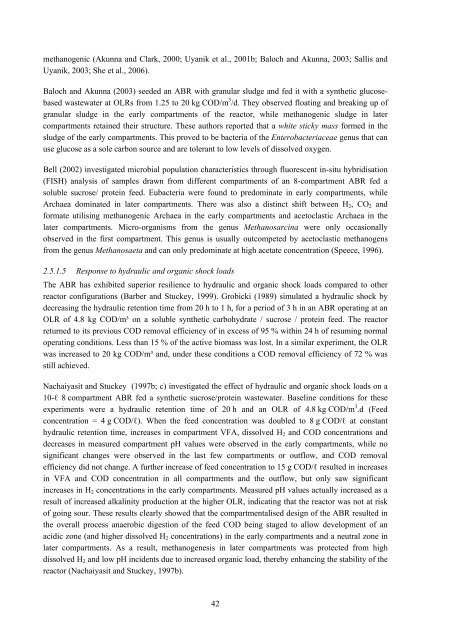analysis of a pilot-scale anaerobic baffled reactor treating domestic ...
analysis of a pilot-scale anaerobic baffled reactor treating domestic ...
analysis of a pilot-scale anaerobic baffled reactor treating domestic ...
You also want an ePaper? Increase the reach of your titles
YUMPU automatically turns print PDFs into web optimized ePapers that Google loves.
methanogenic (Akunna and Clark, 2000; Uyanik et al., 2001b; Baloch and Akunna, 2003; Sallis and<br />
Uyanik, 2003; She et al., 2006).<br />
Baloch and Akunna (2003) seeded an ABR with granular sludge and fed it with a synthetic glucosebased<br />
wastewater at OLRs from 1.25 to 20 kg COD/m 3 /d. They observed floating and breaking up <strong>of</strong><br />
granular sludge in the early compartments <strong>of</strong> the <strong>reactor</strong>, while methanogenic sludge in later<br />
compartments retained their structure. These authors reported that a white sticky mass formed in the<br />
sludge <strong>of</strong> the early compartments. This proved to be bacteria <strong>of</strong> the Enterobacteriaceae genus that can<br />
use glucose as a sole carbon source and are tolerant to low levels <strong>of</strong> dissolved oxygen.<br />
Bell (2002) investigated microbial population characteristics through fluorescent in-situ hybridisation<br />
(FISH) <strong>analysis</strong> <strong>of</strong> samples drawn from different compartments <strong>of</strong> an 8-compartment ABR fed a<br />
soluble sucrose/ protein feed. Eubacteria were found to predominate in early compartments, while<br />
Archaea dominated in later compartments. There was also a distinct shift between H2, CO2 and<br />
formate utilising methanogenic Archaea in the early compartments and acetoclastic Archaea in the<br />
later compartments. Micro-organisms from the genus Methanosarcina were only occasionally<br />
observed in the first compartment. This genus is usually outcompeted by acetoclastic methanogens<br />
from the genus Methanosaeta and can only predominate at high acetate concentration (Speece, 1996).<br />
2.5.1.5 Response to hydraulic and organic shock loads<br />
The ABR has exhibited superior resilience to hydraulic and organic shock loads compared to other<br />
<strong>reactor</strong> configurations (Barber and Stuckey, 1999). Grobicki (1989) simulated a hydraulic shock by<br />
decreasing the hydraulic retention time from 20 h to 1 h, for a period <strong>of</strong> 3 h in an ABR operating at an<br />
OLR <strong>of</strong> 4.8 kg COD/m³ on a soluble synthetic carbohydrate / sucrose / protein feed. The <strong>reactor</strong><br />
returned to its previous COD removal efficiency <strong>of</strong> in excess <strong>of</strong> 95 % within 24 h <strong>of</strong> resuming normal<br />
operating conditions. Less than 15 % <strong>of</strong> the active biomass was lost. In a similar experiment, the OLR<br />
was increased to 20 kg COD/m³ and, under these conditions a COD removal efficiency <strong>of</strong> 72 % was<br />
still achieved.<br />
Nachaiyasit and Stuckey (1997b; c) investigated the effect <strong>of</strong> hydraulic and organic shock loads on a<br />
10-ℓ 8 compartment ABR fed a synthetic sucrose/protein wastewater. Baseline conditions for these<br />
experiments were a hydraulic retention time <strong>of</strong> 20 h and an OLR <strong>of</strong> 4.8 kg COD/m 3 .d (Feed<br />
concentration = 4 g COD/ℓ). When the feed concentration was doubled to 8 g COD/ℓ at constant<br />
hydraulic retention time, increases in compartment VFA, dissolved H2 and COD concentrations and<br />
decreases in measured compartment pH values were observed in the early compartments, while no<br />
significant changes were observed in the last few compartments or outflow, and COD removal<br />
efficiency did not change. A further increase <strong>of</strong> feed concentration to 15 g COD/ℓ resulted in increases<br />
in VFA and COD concentration in all compartments and the outflow, but only saw significant<br />
increases in H2 concentrations in the early compartments. Measured pH values actually increased as a<br />
result <strong>of</strong> increased alkalinity production at the higher OLR, indicating that the <strong>reactor</strong> was not at risk<br />
<strong>of</strong> going sour. These results clearly showed that the compartmentalised design <strong>of</strong> the ABR resulted in<br />
the overall process <strong>anaerobic</strong> digestion <strong>of</strong> the feed COD being staged to allow development <strong>of</strong> an<br />
acidic zone (and higher dissolved H2 concentrations) in the early compartments and a neutral zone in<br />
later compartments. As a result, methanogenesis in later compartments was protected from high<br />
dissolved H2 and low pH incidents due to increased organic load, thereby enhancing the stability <strong>of</strong> the<br />
<strong>reactor</strong> (Nachaiyasit and Stuckey, 1997b).<br />
42
















